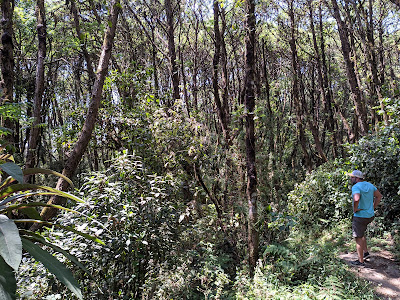 |
| View from our camp |
The World Cup is a global event and the hype around it is palpable even in countries that have not qualified (eg Tanzania). Soccer (football) is truly a global sport and thus fan's allegiances carry over from clubs to national teams making for lively viewing environments. In Tanzania the locals typically support the African teams and generally root for the underdog as well. Going out to watch games at a bar is an awesome experience here even if you are in a small village. People tend to get animated although power cuts are still common which induce a collective groan among the spectators.
This year we were in Pwana Region for most of the group stages and enjoyed watching the first game at lunch (1pm local start time) and then games at 4pm, 7pm and 10pm. We watched nearly all the 1pm and 10pm and 7pm games with highlights including the Saudi Arabia upset over Argentina and Spain's 7-0 trouncing of Costa Rica. The matches were available at one of two bars in the village and we suffered several powercuts. The funniest thing about the powercuts is that there is no way of knowing exactly when the power will come back. There can be a packed bar with 50 people and I've always found the dispersal patterns to be fascinating as some leave right away and others mill about until after the match ends and there is truly no hope to view the conclusion. It's not unusual for big matches to have local bars and sports joints advertise the fact that they have a generator on site.
We then traveled to Dar es Salaam and the place we were staying was next to a mall that showed the games on massive screen outdoors. Portugal's 3-2 victor over Ghana was a highlight of our viewing in Dar with a very pro-Ghana contingent pitted against Ronaldo fanboys. We then headed back to Ruaha for the end of the group stages and semi-final. Streaming is tough from our tent and the biggest challenge was when games went into penalties (most notably Spain and Croatia) the streams got overloaded causing them to collapse at the exact moment you wanted the stream the most. We watched on our computers and also used our projector when it was dark enough.
Back in Iringa town we had a better internet connection but streams were still overloaded. We eventually found a work around which involved streaming on two simultaneous computers, one in Spanish and in English. Between constant refreshing of streams we were guaranteed to see the action (see video below).
This years World Cup was truly one for the ages, especially the night of Argentina/Netherlands and Croatia/Brazil. They were two back to back games that featured come backs and penalty shootouts. I was up late screaming and stomping around the room.
Unfortunately were were quite busy for the final and didn't get a chance to watch it in a public venue. We enjoyed the exciting game from the comfort of our home, two computers simultaneously running, a seamless viewing experience that was only possible due to our practice overcoming adversity throughout the tournament.
 |
| Enjoying from the comfort of our bed. |
















































